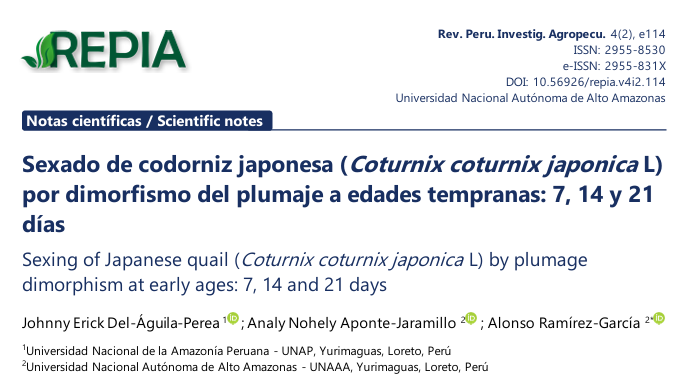Sexing of Japanese quail (Coturnix coturnix japonica L) by plumage dimorphism at early ages: 7, 14 and 21 days
DOI:
https://doi.org/10.56926/repia.v4i2.114Keywords:
certainty, coloration, females, males, precisionAbstract
This study aimed to evaluate the accuracy of sexing Japanese quails (Coturnix coturnix japonica) using sexual plumage dimorphism, in order to identify the earliest age at which sex can be determined with high certainty. The research was conducted at the Poultry Experimental Unit of the National Agrarian University of La Molina (UNALM), using 2,700 newly hatched quails artificially incubated. Three sexing assessments based on plumage coloration were conducted at 7 (T1), 14 (T2), and 21 (T3) days of age, through direct observation: females were identified by the presence of black arrowhead-shaped spots on their breasts, while males had uniform beige plumage. The birds were raised until 35 days, at which age sex was confirmed with 100% certainty to validate previous results. Statistical analysis using the chi-square test (χ²) showed significant differences between T1 and T2, as well as between T1 and T3, while no significant differences were found between T2 and T3. These results suggest that sexing by plumage dimorphism is adequate from 14 days of age (T2) and is most reliable at 21 days of age (T3).
Downloads
References
Calzada, J. (1982). Métodos estadísticos para la investigación. Editorial Milagros, 5ta ed.
Ciriaco, P. (1999). Crianza de codornices. Programa de Investigación y Proyección Social en Aves. Departamento de Producción Animal. Universidad Nacional Agraria La Molina. Lima, Perú.
El Full, E. A., & Ragab, M. S. (2005). Results of two morphological practical methods for sex determination in japanese quail. Fayoum Journal of Agricultural Research and Development, 19(1), 133–140. https://doi.org/10.21608/FJARD.2005.197805 DOI: https://doi.org/10.21608/fjard.2005.197805
Emam, A. M., Semida, D. A., El-Full, E. A., Mahmoud, B. Y., Abdel-Azim, A. M., & Elnesr, S. S. (2024). Is the sex ratio of Japanese quail offspring equal? Tropical Animal Health and Production, 56(8), 384. https://doi.org/10.1007/S11250-024-04224-3 DOI: https://doi.org/10.1007/s11250-024-04224-3
Figueroa, E., & Sulca, A. (1999). Manual Básico. Producción de codornices. Centro de Extensión Universitaria y Proyección Social. Laboratorio de Patología Aviar y Producción Avícola. Facultad de Medicina Veterinaria. Universidad Nacional Mayor de San Marcos. Lima, Perú.
Galíndez, R., De Basilio, V., Martínez, G., Vargas, D., Uztariz, E., & Mejía, P. (2009). Evaluación de la fertilidad y eclosión en la codorniz japonesa. Zootecnia Tropical, 27(1), 007–018. https://ve.scielo.org/scielo.php?script=sci_arttext&pid=S0798-72692009000100002
Grimaldos, D. O. (2020). Guía para la producción de codornices y sus derivados. Universidad Cooperativa de Colombia, Facultad de Ciencias de la Salud, Medicina Veterinaria y Zootecnia, Bucaramanga. https://hdl.handle.net/20.500.12494/20353
Gutiérrez, M. de los Á. (2025). Crecimiento del sector avícola en Perú: Aumento de producción de pollo y huevos en 2024. Arch. Zootec, 57(219).
Homma, K., Siopes, T. D., Wilson, W. O., & McFarland, L. Z. (1966). Identification of sex of day-old quail (Coturnix coturnix japonica) by cloacal examination. Poultry Science, 45(3), 469–472. https://doi.org/10.3382/PS.0450469 DOI: https://doi.org/10.3382/ps.0450469
Hortúa-López, L. C., Cerón-Muñoz, M. F., Zaragoza-Martínez, M. de L., & Angulo-Arizala, J. (2021). Backyard poultry: contributions and opportunities for the peasant family. Agronomía Mesoamericana, 32(3), 1019–1033. https://doi.org/10.15517/AM.V32I3.42903 DOI: https://doi.org/10.15517/am.v32i3.42903
Kirrella, A. A. K., El-Kassas, S., Mostfa, S. M., Younes, H. H., Helal, M., & Ragab, M. (2023). The comparison of two different plumage-color lines of Japanese quail (Coturnix japonica) disclosed a significant effect in increasing abdominal fat contents with increasing age. Tropical Animal Health and Production, 55(3). https://doi.org/10.1007/S11250-023-03601-8 DOI: https://doi.org/10.1007/s11250-023-03601-8
Lucotte, G. (1990). La codorniz cría y explotación (2nd ed.). Mundi-Prensa. Madrid, España.
Mahmoud, B. Y., Abdel Hafez, A. S., Emam, A. M., Abdelmoniem, A. M., & Elsafty, S. A. (2018). Feathering rate impact on growth and slaughter traits of Japanese quail. Journal of Agricultural Science, 156(7), 942–948. https://doi.org/10.1017/S0021859618000990 DOI: https://doi.org/10.1017/S0021859618000990
Melo, T. V., Ferreira, R. A., Carneiro, J. B. A., Oliveira, V. C., Moura, A. M. A., Silva, C. S., & Nery, V. L. H. (2008). Rendimiento de codornices japonesas utilizando harina de algas marinas y fosfato monoamónico. Archivos de Zootecnia, 57(219), 381–384. https://www.redalyc.org/pdf/495/49515005018.pdf
Moraes, J., Takahara, A., Dos Ouros, C. C., De Souza, K., Costa, G., Souza, T., De Britto, A., & Antônio, E. (2022). Beak trimming in japanese quails at initial phase is an alternative to reduce the negative effects of feather pecking. Acta Scientiarum. Animal Sciences, 44. https://doi.org/10.4025/actascianimsci.v44i1.54129 DOI: https://doi.org/10.4025/actascianimsci.v44i1.54129
Pérez, A., & Pérez, F. (1974). Coturnicultura: Tratado de cría y explotación industrial de codornices. Científico-Médica. Barcelona, España.
Resende, R., Martins, E., Georg, P., Paiva, E., Conti, A., Santos, A., Sakaguti, E., & Murakami, A. (2005). Variance components for body weight in Japanese quails (Coturnix japonica). Brazilian Journal of Poultry Science, 7(1), 23–25. https://doi.org/10.1590/S1516-635X2005000100004 DOI: https://doi.org/10.1590/S1516-635X2005000100004
Szara, T., Duro, S., Gündemir, O., & Demircioglu, I. (2022). Sex determination in japanese quails (Coturnix japonica) using geometric morphometrics of the skull. Animals, 12(3), 302. https://doi.org/10.3390/ANI12030302 DOI: https://doi.org/10.3390/ani12030302
Vásquez, R. E., & Ballesteros, H. H. (2020). La cría de codornices. Manejo empresarial del campo. https://content.e-bookshelf.de/media/reading/L-4036642-2fa9cf2c6d.pdf
Wegner, M., Kokoszyński, D., Żochowska-Kujawska, J., Kotowicz, M., Włodarczyk, K., Banaszewska, D., & Batkowska, J. (2024). The influence of genotype and sex on carcass composition, meat quality, digestive system morphometry and leg bone dimensions in Japanese quails (C. coturnix japonica). Scientific Reports, 14(1). https://doi.org/10.1038/S41598-024-70496-2 DOI: https://doi.org/10.1038/s41598-024-70496-2

Downloads
Published
How to Cite
Issue
Section
License
Copyright (c) 2025 Johnny Erick Del-Águila-Perea, Analy Nohely Aponte-Jaramillo, Alonso Ramírez-García

This work is licensed under a Creative Commons Attribution 4.0 International License.
Authors retain their rights:
a. The authors retain the intellectual property rights (copyright) of the published works, assigning to the journal the right of first publication.
b. Authors retain their trademark and patent rights, and also on any process or procedure described in the article.
c. Authors retain the right to share, copy, distribute, perform and publicly communicate the article published in REPIA (e.g., place it in an institutional repository or publish it in a book), with an acknowledgement of its initial publication in REPIA.
d. Authors retain the right to make a subsequent publication of their work, to use the article or any part of it (e.g., a compilation of their work, notes for conferences, theses, or for a book), provided they indicate the source of publication (authors of the work, journal, volume, number, and date).







